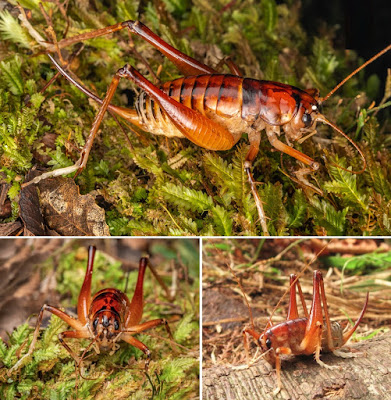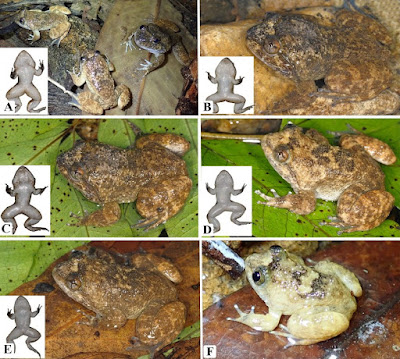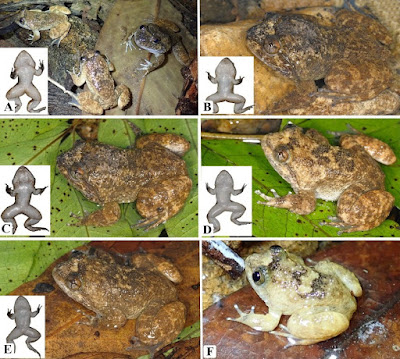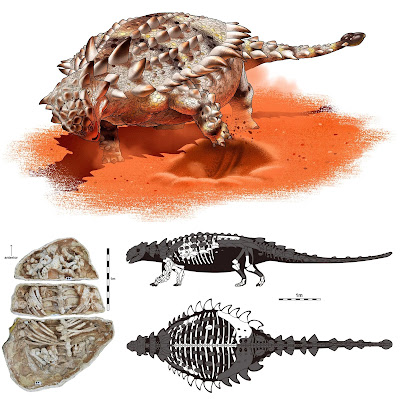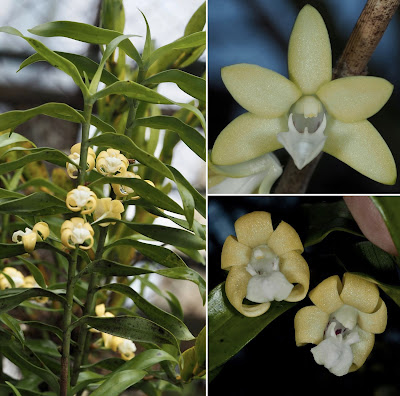[Most Recent Entries] [Calendar View]
Saturday, March 20th, 2021
| Time | Event | ||||
| 6:00a | [Entomology • 2021] Hemiandrus jacinda • A New Species of Large Hemiandrus Ground Wētā (Orthoptera: Anostostomatidae) from North Island, New Zealand
Abstract A new species of Hemiandrus ground wētā is described from North Island, New Zealand. Hemiandrus jacinda sp. nov. is larger and more brightly coloured than other species in the region, but appears to be scarce and restricted to remnant native forest habitat. Keywords: Orthoptera, Anostostomatidae, Hemiandrus, ground wētā, new species, North Island, New Zealand, Jacinda Ardern
Class: Insecta Order: Orthoptera Suborder: Ensifera Superfamily: Stenopelmatoidea Burmeister, 1838 Family: Anostostomatidae Saussure, 1859 Genus: Hemiandrus Ander, 1938. Hemiandrus jacinda sp. nov. Diagnosis: A comparatively large, long-limbed, glossy and predominantly orange-red Hemiandrus. The maxillary palp with 3rd segment naked and 4th segment pilose on distal section. Body with posterior edges of segments darker than anterior, and with longitudinal bands. Fore tibiae with single articulated superior prolateral linear spine. Mid tibiae 1½ times length of pronotum. Hind femura with one prolateral apical spine and one retrolateral alpical spine. Adult female with weakly curved ovipositor ¾ body length and a pair of slerotised cusps on the posterior margin of sternite S6. Male with protruding section of the subgenital plate forming two fingers. Etymology. This long-limbed, red species is named for New Zealand Prime Minister (2017– ) Jacinda Kate Laurell Ardern Steven A. Trewick. 2021. A New Species of Large Hemiandrus Ground Wētā (Orthoptera: Anostostomatidae) from North Island, New Zealand. Zootaxa. 4942(2); 207–218. DOI: 10.11646/zootaxa.4942.2.4 | ||||
| 6:45a | [Herpetology • 2020] Limnonectes phuyenensis • A New Species of Limnonectes (Anura: Dicroglossidae) from South-central Vietnam
Abstract A new species of Limnonectes from Phu Yen Province, South-central Vietnam is described based on morphological and molecular differences. Morphologically, the new species is distinguishable from its congeners on the basis of a combination of the following diagnostic characters: SVL 49.8–77.9 mm in males, 40.8–61.8 mm in females; males with moderately enlarged head (HL/SVL 0.47, HW/SVL 0.48); head slightly broader than long (HL/HW 0.97 in males, 0.95 in females); vomerine teeth present; external vocal sacs absent; rostral length short (RL/SVL 0.15); tympanum invisible; dorsal surface of head, body and flanks with ridges and tubercles; dorsal surface of tibia and foot distinctly tuberculate, covered with moderately dense, small, low tubercles; supratympanic fold present; dorsolateral fold absent; Finger I with nuptial pad, composed of minute spines on dorsal surface and medial edge in males; toes webbed to distal of terminal phalanx, webbing formula I0–0II0–0III0–0IV0-–0V0; in life, dorsum yellowish brown with dark brown markings; ventral surface white with brown markings. In phylogenetic analyses, the new species from Vietnam and Limnonectes fastigatus as well as L. kiziriani form a clade, which is sister to L. fragilis from China, although the nodal support values for the set of relationships are insignificant from all analyses. Keywords: Amphibia, Limnonectes phuyenensis sp. nov., molecular phylogeny, taxonomy, Phu Yen Province Limnonectes phuyenensis sp. nov. Etymology. The specific epithet "phuyenensis" refers to the type locality of the new species, Phu Yen Province. As common names we suggest Phu Yen Wart Frog (English), Ếch nhẽo phú yên (Vietnamese). Cuong The Pham, Dang Trong Do, Minh Duc Le, Hanh Thi Ngo, Luan Thanh Nguyen, Thomas Ziegler and Truong Quang Nguyen. 2020. A New Species of Limnonectes (Amphibia: Anura: Dicroglossidae) from Vietnam. Zootaxa. 4894(3); 387–402. DOI: 10.11646/zootaxa.4894.3.5 | ||||
| 7:24a | [Paleontology • 2021] A New Ankylosaurid Skeleton from the Upper Cretaceous Baruungoyot Formation of Mongolia: Its Implications for Ankylosaurid Postcranial Evolution
Abstract A new articulated postcranial specimen of an indeterminate ankylosaurid dinosaur from the Upper Cretaceous (middle-upper Campanian) Baruungoyot Formation from Hermiin Tsav, southern Gobi Desert, Mongolia includes twelve dorsal vertebrae, ribs, pectoral girdles, forelimbs, pelvic girdles, hind limbs, and free osteoderms. The new specimen shows that Asian ankylosaurids evolved rigid bodies with a decreased number of pedal phalanges. It also implies that there were at least two forms of flank armor within Ankylosauridae, one with spine-like osteoderms and the other with keeled rhomboidal osteoderms. Unique anatomical features related to digging are present in Ankylosauridae, such as dorsoventrally flattened and fusiform body shapes, extensively fused series of vertebrae, anteroposteriorly broadened dorsal ribs, a robust humerus with a well-developed deltopectoral crest, a short robust ulna with a well-developed olecranon process, a trowel-like manus, and decreased numbers of pedal phalanges. Although not fossorial, ankylosaurids were likely able to dig the substrate, taking advantage of it for self-defence and survival. Systematic paleontology Dinosauria Owen, 1842 Ankylosauridae Brown, 1908 Ankylosauridae, gen. et sp. indet. Material: MPC-D 100/1359 (Figs. 1, 2, 3), a nearly complete postcranial skeleton that lacks the tail but includes twelve dorsal vertebrae, ribs, pectoral girdles, forelimbs, pelvic girdles, hindlimbs, and free osteoderms.
Jin-Young Park, Yuong-Nam Lee, Philip J. Currie, Michael J. Ryan, Phil Bell, Robin Sissons, Eva B. Koppelhus, Rinchen Barsbold, Sungjin Lee and Su-Hwan Kim. 2021. A New Ankylosaurid Skeleton from the Upper Cretaceous Baruungoyot Formation of Mongolia: Its Implications for Ankylosaurid Postcranial Evolution. Scientific Reports. 11: 4101. DOI: 10.1038/s41598-021-83568-4 | ||||
| 10:03a | [Botany • 2021] Dendrobium niveolabium (Orchidaceae: Dendrobiinae) • A New Species of Dendrobium section Grastidium from Papua, Indonesia
Abstract Dendrobium niveolabium Handoyo, Naive, Ormerod & Champion, a new species of Dendrobium section Grastidium is herein described and illustrated from Papua Province in Indonesia. Detailed description, colour plates, comparison with its allied taxa, phenology, distribution and a preliminary conservation assessment are provided. Keywords: Dendrobieae, section Grastidium, New Guinea, Papuasian flora, Tropical botany, Magnoliids Dendrobium niveolabium Handoyo, Naive, Ormerod & J.Champ. Mark Arcebal Kling Naive, Frankie Handoyo, Paul Ormerod and Jeffrey Champion. 2021. Dendrobium niveolabium (Orchidaceae, Section Grastidium), A New Dendrobiinae Species from Papua, Indonesia. Phytotaxa. 490.3; 271–277. DOI: 10.11646/phytotaxa.490.3.5 |
| << Previous Day |
2021/03/20 [Calendar] |
Next Day >> |
